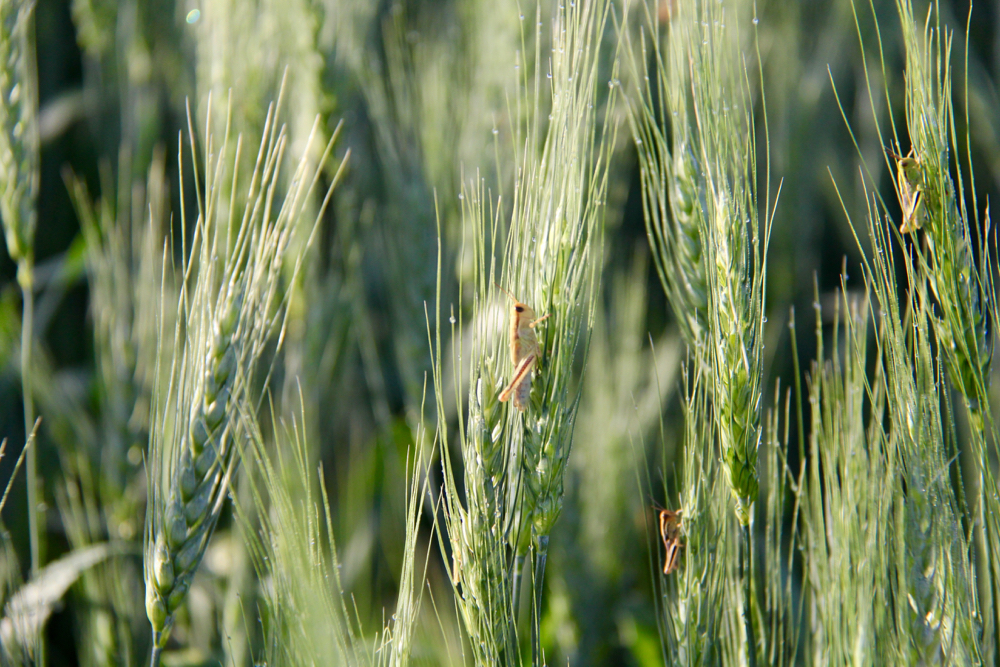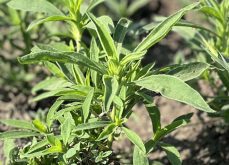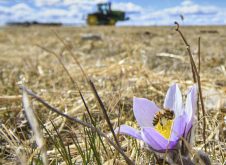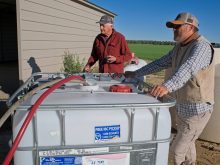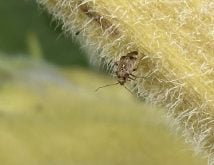Western Canadian farmers are hoping that common sense prevails in Ottawa before a potentially serious outbreak of insect crop pests play havoc with grain, oilseed and pulse crops across the Prairies this growing season.
News that a cost-effective insecticide that controls a wide range of pests like grasshoppers and flea beetles won’t be available to Canadian farmers this April is causing disbelief and collective headshaking across both crop and livestock production sectors.
Here’s the issue. The Pest Management Regulatory Agency (PMRA), part of Health Canada, has determined after a review of health and environmental data the long-standing insecticide lambda-cyhalothrin continues to be safe for use to control pests in crops intended for human food consumption, but starting this April cannot be used on any crop that may be used for livestock feed. This affects the use of familiar insecticide products such as Matador and Silencer.
Read Also

Claas brings 1000 Series SP forage harvesters to Canada
In mid-August, Claas unveiled its new line of Jaguar forage harvesters at an event in Visalia, California, deep in the heart of that state’s dairy region.
What grains, oilseeds or pulse crops or their byproducts grown in Western Canada, which are dependent on weather and market conditions, won’t be used for livestock feed? Well, none. There aren’t any exceptions.
Virtually every crop grown, for one reason or another, could end up as feed or bedding for some class of livestock.
Recognizing that situation, Syngenta Canada voluntarily pulled its leading insecticide Matador off the shelf for 2023, while Adama has at least temporarily made a similar move with its popular pest control product Silencer.
Those aren’t the only two brand name products affected but are a couple of the most popular.
The situation has far-reaching ramifications across both crop and livestock production sectors.
For this farmer panel, frustrations are over a few key points: a loss of lambda-cy products for 2023 is one important tool removed from the crop protection tool box; there doesn’t appear to be any science-based reasoning behind the decision; and while there are other excellent (non-lambda-cy) products, what are their costs and availability?
Here is what farmer panel members had to say about changes in lambda-cy regulations.
Dallas Leduc
Glentworth, Sask.
For southern Saskatchewan farmer Dallas Leduc, loss of products such as Matador and Silencer is “a very bad situation,” as he considers a repeat, or worse, of a bad grasshopper season without those effective products.
Leduc, who produces about 10,000 acres of grains, oilseeds and pulse crops near Glentworth, about 170 kilometres south of Swift Current, says he made at least one and on some crops two or more applications of lambda-cy products in 2022 to control a bad outbreak of grasshoppers.
“Some people in the area used an insecticide with their pre-seed burndown application,” says Leduc. “The season started that early, and then there were several more applications after that. The lambda products are easy to use, effective and also cost effective.”

Leduc says his bill for insecticides in 2022 was “more than six figures.” He notes there are effective alternative products to lambda-cy insecticides, but some are also quite expensive.
Some reports cite lambda-cy products in the $6-per-acre range, while another leading product, Coragen, with the active ingredient Rynaxypyr, is about $20 per acre.
“Don’t get me wrong, Coragen is a nice product, and it has a bit of a residual effect, but it is also about three times the money,” says Leduc.
He’s hoping — probably against the odds — that the 2023 grasshopper season isn’t as bad as 2022. Time will tell.
Owen Orsak
Binscarth, Man.
In west-central Manitoba, Owen Orsak does his best to minimize the use of insecticides, but at the same time regrets the fact these effective products won’t be available for 2023.

“I’m sorry to see it’s another tool that isn’t available for Canadian farmers this growing season,” says Orsak, who crops about 5,000 acres of grains and oilseeds at Binscarth, northwest of Brandon and east of the Saskatchewan border. He points out that Lorsban was an effective insecticide taken off the market in 2022 and now lambda-cy products have been put on hold.
Orsak says for his farm flea beetles on canola are usually the most common pest, although cutworms can be a concern some years.
Wheat midge hasn’t been a huge issue since he’s been growing midge-tolerant wheat varieties for several years, but in 2023 he’ll be growing a wheat that doesn’t have midge tolerance. He’s not sure what to expect.
While circumstances vary, Orsak says some years he will treat part of a canola field with a flea beetle control product such as Matador.
“I don’t like using an insecticide any more than I have to,” he says. “With our cropping system, I don’t believe our flea beetle pressure is as great as it is in other areas. We don’t blacken the soil, but with minimum tillage there is some disturbance of crop residue and that seems to reduce the number of flea beetles.”
Depending on the year, Orsak says the headlands seem to have more flea beetles than the centre of the field. In that situation, he may make a couple of sprayer-width passes over the headlands to control flea beetles and leave the rest.
“And I also believe the canola crop is pretty resilient,” he says. “If our greatest insect pressure is on 10 per cent of the field, I will treat the headlands and not worry about the other 90 per cent. Canola can handle some insect pressure.”
Gerrid Gust
Davidson, Sask.
As a producer of grains, oilseeds and pulse crops in central Saskatchewan, Gerrid Gust says he is disappointed to see the loss of another crop input for what appears to be no scientific reason.
Gust, who crops about 14,000 acres with family members at Davidson, about halfway between Regina and Saskatoon, says at their farm they don’t always need to apply pesticides, but when it is needed pesticide options are limited.

“We have this loss of the lambda-cyhalothrin products. Last year Lorsban was taken off the market. We almost lost the use of neonicotinoid pesticides, and these are very safe, very selective products,” he says.
“We lose these effective products and then, as an industry, we are supposed to be increasing production to feed the world and hopefully make a profit. While at the same time, insects that reduce yield are able to run rampant.
“We are losing another tool from the crop protection tool box for no scientific reason, but apparently for the sake of advocacy.”
Gust says it doesn’t make sense to be able to use the lambda-cy insecticides on some horticultural crops that go directly to consumers while not being able to use them on a canola crop that is going to remain in the field for another 90 days, be processed into oil, then, as a byproduct of that, meal for livestock.
He says it’s like someone trying to imagine the worst possible scenario and then deciding to change the regulations without any scientific reason.
“Canada has a reputation for producing very high quality crops, being very responsible and applying very safe production practices,” says Gust.
“We are the gold standard. So now if there are reduced yields, some other country with poorer production practices may supply the market. It doesn’t make much sense.”
Corey Loessin
Radisson, Sask.
Corey Loessin is concerned about what the loss of lambda-cyhalothrin products will mean for striped flea beetle control in his part of Saskatchewan, northwest of Saskatoon.

“Striped flea beetles have been an increasing problem in canola crops in this area,” says Loessin.
“And the lambda-cy products worked well. They were safe and they were economical. I know there are other pest control products on the market, but what is their availability?
“Aside from flea beetles, I’m concerned about what will happen with grasshoppers this year in certain parts of the province. They were really bad in 2022 and the forecast for 2023 isn’t great.
“Also, I am concerned about the supply issue. Often when there is a pest problem it can appear rather suddenly and you need to act quickly,” he says. “Are these alternative products going to be available when they are needed?”
Loessin, who is also a director at Saskatchewan Pulse Growers (SPG), notes that until now, the only product licensed for aphid control on lentils was a lambda-cy product.
“There is a new product that has just been registered, Carbine (it has an anti-feeding mode of action). It may be quite effective, but will it be available?”
As the SPG joins other commodity associations and commissions appealing to Health Canada and PMRA to reconsider the change in lambda-cy regulations, Loessin says it is a very confusing situation.
“To me, it is a straight up error on the part of PMRA to designate feed as an off-label use with these products,” he says.
“There is no science. There is no testing mechanism for feed whatsoever to determine if there is pesticide residue. There are so many questions to be answered. The situation they have created is completely unworkable.”
Roger Chevraux
Killam, Alta.
As a north-central Alberta farmer and recently elected chair of the Alberta Canola Producers Commission, Roger Chevraux says he is worried about the potential effects changes in lambda-cyhalothrin regulations will have on both crop and livestock sectors.

Chevraux says if the situation doesn’t change — if Health Canada and PMRA don’t reverse or at least pause this regulation — there are many questions that must be answered not just on how it will affect crop production but the feeding of livestock as well as trade under the Canada-United States-Mexico Agreement.
Chevraux, who farms at Killam, about 165 kilometres southeast of Edmonton, says if the situation doesn’t change, he is concerned about what products will be available for his farm to control pests such as grasshoppers, flea beetles, cutworms and diamondback moths.
These pests are not all an immediate threat for the 2023 growing season, but depending on weather and prevailing winds, conditions can change.
“I am extremely concerned about how this will play out depending on when and where there are insect outbreaks,” says Chevraux.
“And it is not just an issue for crop producers but also for the livestock industry.”
Chevraux says this confusing situation with lambda-cy insecticide started in 2017, when PMRA reviewed health and environmental data to evaluate the safety of its chemistry. The data review process is a normal practice after a chemical has been on the market for 15 years or more.
The U.S. Environmental Protection Agency (EPA) undertook a similar review of the lambda-cy chemistry data at the same time.
Chevraux says it appears PMRA relied on some older data and technology to evaluate the chemistry and concluded there was a concern about the chemical being used on crops that produce livestock feed.
There wasn’t any scientific data, but computer modelling indicated there may be a risk. That led to excluding feed crops from the label.
The EPA used updated technology to review data and concluded that the lambda-cy chemistry was safe to use on all counts — on both food and feed crops.
While this would have been compelling data for PMRA to consider, the agency said the EPA information arrived after the review period had closed and therefore could not be considered.
Chevraux says the lambda-cy chemistry is used in several important insecticide products used by western Canadian farmers.
While there are alternative products available to control most insect pests, there is some uncertainty whether there will be sufficient supply. Chevraux says it is difficult to crank up a production line overnight.
There is also a question about what might happen with the 2022 crop that is still in the bin.
Can it be used in 2023? Will grain elevators require farmers to sign a declaration when they deliver their crops?
And, since the United States allows the use of lambda-cy chemistry for insect control, what are the implications of corn or dry distillers grain being shipped to Canadian feedlots? Will that still be allowed?
“There is a lot of uncertainty about the impact of this regulation and how it will be enforced,” says Chevraux.
He’s hoping a united appeal by Canadian commodity organizations will encourage Health Canada and PMRA to reconsider its decision.
Although efforts were made to reach PMRA for comments, as of publication time no response had been received and no updates about the review ruling had been posted on the agency’s website.


